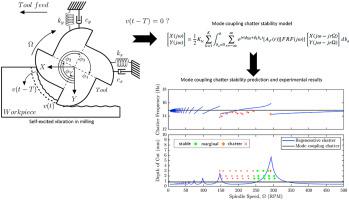International Journal of Machine Tools and Manufacture ( IF 14.0 ) Pub Date : 2021-05-08 , DOI: 10.1016/j.ijmachtools.2021.103738 Huseyin Celikag , Erdem Ozturk , Neil D. Sims

|
In milling, two different self-excited vibrations have been reported; regenerative and mode coupling chatter. The regenerative chatter mechanism has been extensively studied and validated with tests whereas mode coupling chatter mechanism was reported a long time ago for threading operations. The presented mode coupling chatter models were based only on current vibrations of the system but not on the delayed vibrations. With the increase in the research carried out on robotic milling operations, the low frequency severe self-excited vibrations at high spindle speeds were claimed to be mode coupling chatter by many researchers. However, the justification of mode coupling chatter mechanism is absent from predicted stability boundaries and a strong evidence distinguishing it from regenerative chatter mechanism is not present. Additionally, mode coupling chatter models applied to milling was based on threading operations and hence they were not capturing the characteristics of intermittent milling process. Therefore, this paper focuses on the diagnosis of mode coupling chatter in robotic milling. Mode coupling chatter principles are applied to milling process considering its intermittent characteristics. The zeroth order approximation for mode coupling chatter mechanism is adapted for milling and extended to multi frequency approximation. Mode coupling chatter stability boundaries are calculated, explored with tests and compared with regenerative chatter stability boundaries. Results show that mode coupling chatter stability boundaries are very low and vaguely dependent on the spindle speed. This contradicts the stability observed in the experimental tests. Hence, it is concluded that mode coupling chatter in milling is not possible, because the assumption of the chip thickness depending only on current vibrations does not apply to milling operations. The novelty of the presented paper is the theoretical and experimental justification that mode coupling chatter is not possible in milling operations.
中文翻译:

铣削中会发生模式耦合颤动吗?
在铣削过程中,已经报道了两种不同的自激振动。再生和模式耦合颤振。再生颤动机制已被广泛研究并通过测试进行了验证,而模式耦合颤动机制早在很久以前就被报道用于线程操作。提出的模式耦合颤振模型仅基于系统的当前振动,而不基于延迟的振动。随着对机器人铣削操作的研究的增加,许多研究人员声称,高主轴转速下的低频严重自激振动是模式耦合颤振。但是,模式耦合颤振机制的合理性尚缺乏预测的稳定性边界,也没有强有力的证据将其与再生颤动机制区分开。此外,应用于铣削的模式耦合颤振模型基于螺纹加工操作,因此它们未捕获间歇铣削过程的特征。因此,本文着重于机器人铣削中模式耦合颤振的诊断。考虑到其间歇性特性,将模式耦合颤振原理应用于铣削过程。模式耦合颤振机构的零阶近似适用于铣削,并扩展到多频近似。计算模式耦合颤振稳定性边界,通过测试进行探索,并将其与再生颤振稳定性边界进行比较。结果表明,模式耦合颤振稳定性边界非常低,并且模糊地取决于主轴速度。这与在实验测试中观察到的稳定性相矛盾。因此,可以得出结论,铣削中的模式耦合颤动是不可能的,因为仅取决于当前振动的切屑厚度假设不适用于铣削操作。提出的论文的新颖性是在铣削操作中不可能进行模式耦合颤动的理论和实验证明。











































 京公网安备 11010802027423号
京公网安备 11010802027423号